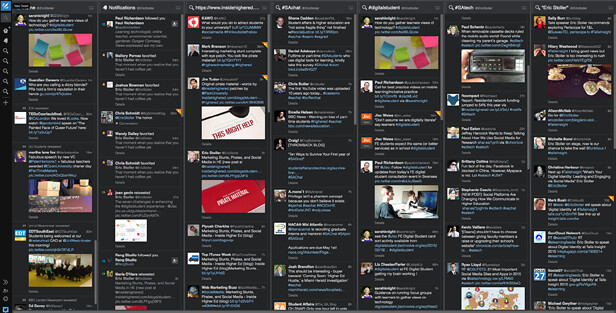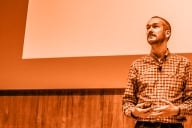You have /5 articles left.
Sign up for a free account or log in.
This post is a story. It's the story of how I've used the social media tools and techniques that I teach to students, staff, and faculty as a springboard for getting myself connected to the higher education scene in the UK. When my wife received an offer to work for her company's UK office in London, it was an offer that was too good to refuse. Of course there were all sorts of conversations about when we would move, where we would live, and what I would do with myself. What made it particularly epic for me was the fact that I grew up on a gravel road in Iowa. It was the epitome of rural. Okay, so moving to London was a big deal.
Being an established higher education consultant, speaker, and writer in the United States, I had one UK contact who I had ever met in-person. My UK social media contacts were almost as limited. While I knew that I would maintain my North American consulting/speaking operation, I wanted to work as much as possible in the UK. The task of expanding my business "across the pond" represented a unique challenge to my career. Thankfully, social media channels accelerated my ability to make connections with UK higher education professionals, institutions, and associations.
Whenever I'm teaching social media for career development, I always spend a considerable amount of time talking about Twitter and LinkedIn. They are versatile sites/apps that lend themselves to strategic search, networking, engagement, and listening.
However, in order to find the right people and organizations to follow, I had to do some digging. Several Google searches later, I had found a number of accounts to connect to on Twitter and LinkedIn.
My next step was to use TweetDeck to create a social media listening dashboard. Whenever someone in the UK mentioned a new account or hashtag, I immediately checked it out. Tweets led to new users to follow and countless hashtags to investigate.
One of the hashtags that I added to TweetDeck was #digitalstudent. This particular hashtag was associated with Jisc, an organization in the UK that is all about higher education and technology. Several new additions to my social network came out from tweets from Jisc as well as from the #digitalstudent tweets. I even shared some digital literacy resources from Jisc in a post for Inside Higher Ed.
Another benefit of following so many UK higher education accounts on Twitter was that my "Top Tweets and Stories" emails started to include a wide array of new accounts by way of related tweets. I can't imagine how long it would have taken me to build up my UK network without Twitter.
Additionally, I became a member of as many relevant UK higher education LinkedIn groups as I could find. Reading posts and discussions gave me a lot of insight into the challenges and opportunities in UK higher education. And, I changed my geo-location to London, UK on Twitter and LinkedIn. It's the small steps that always come in handy later on.
Remember my UK contact, the one person in the UK who I had met in-person? Well, his name is Simon Thomson. As the Head of E-Learning at Leeds Beckett University, he immediately responded when I tweeted out that I was able to work in the UK.
My first speaking/consulting gig in the UK took place in February at Leeds Beckett University. Twitter was the conduit for the connection. Reading Simon's tweets also led me to an event called "Talis Insight." Simon was on the roster of speakers and the event looked interesting, so I signed up. After registering for the conference, I emailed the organizers and asked if they had any speaker slots that they needed to fill. They got back to me and said that the schedule was already set. Then, unexpectedly, a representative from Talis Insight emailed me and asked if I was still available to speak about digital identity at the event. Apparently, Simon had had to cancel due to another engagement. I immediately accepted their offer and was excited by the serendipity of it all.
Last week at Talis Insight, I gave a talk on digital identity and social media. Essentially, my talk focused on how you use could social media channels like Twitter and LinkedIn to make connections, listen, and learn. The audience seemed particularly interested in Yik Yak and Periscope. Here are the slides from that talk:
At Talis Insight, I had the opportunity to meet Dave White. Dave was someone who I had followed and interacted with on Twitter. His work on "visitors and residents" and how people engage with the web is worth a read.
Speaking of engagement, LinkedIn might not necessarily be the most exciting social media platform, but it turns out that by changing my location, I had by default, added my presence to the UK higher education scene.
A couple of months after I switched my LinkedIn location from Boston to London, I received a LinkedIn message from Vivi Friedgut of Blackbullion that she wanted to chat about higher education. Vivi's company works in the UK higher education sector to improve student financial literacy and employability. And, she found me via a simple edit on my LinkedIn profile. I tell students all of the time that LinkedIn is important...and here was a terrific example. After chatting about digital identity, financial literacy, and career development, Vivi introduced me via email to some terrific UK higher education professionals including Dr. Kenton Lewis, MBE. He has a medal for being "most excellent!"
It takes a lot of work to use social media for listening and learning. I'm constantly following, engaging, and absorbing knowledge. The connections and networking opportunities are limitless and the benefits are obvious. Social media provide a powerful mechanism for professional engagement. In my case, Twitter and LinkedIn jumpstarted my entrance into the UK as a higher education consultant.
I probably should note that email is still vastly important for networking and making professional connections.
Do you tweet? Let's connect. Follow me on Twitter.
[Image credit]






